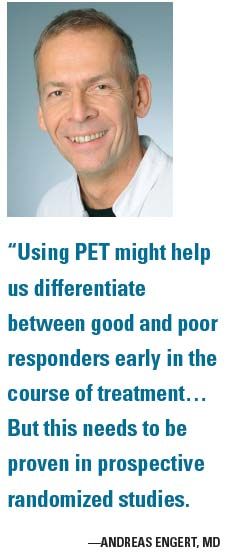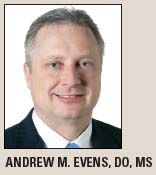Lower Dose Chemotherapy Plus Radiation Offers Favorable Prognosis in Hodgkin’s Lymphoma Patients
Patients with early-stage Hodgkin’s lymphoma and a favorable prognosis can be treated with less intensive chemotherapy and radiotherapy regimens without affecting outcomes. This is the first study to show that less intensive therapy can be used without sacrificing benefits, according to lead author Andreas Engert, MD, and colleagues.
Patients with early-stage Hodgkin’s lymphoma and a favorable prognosis can be treated with less intensive chemotherapy and radiotherapy regimens without affecting outcomes. This is the first study to show that less intensive therapy can be used without sacrificing benefits, according to lead author Andreas Engert, MD, and colleagues.
"I think the study will be practice-changing for the treatment of early-stage Hodgkin’s lymphoma patients with favorable prognoses," said Dr. Engert, a professor of internal medicine, hematology, and oncology at the University Hospital of Cologne in Germany.
Subjects in the German Hodgkin Study Group randomized trial treated with less intensive regimens suffered fewer adverse events and less acute toxic effects of treatment from both chemotherapy and radiotherapy. Mortality and occurrence of secondary cancers after a median follow up of 7.5 years was not significantly different between those treated with more intensive regimens and those who underwent less intensive chemotherapy and radiotherapy.

"The most relevant finding of our study is that treatment intensity can be safely reduced for patients with early favorable Hodgkin’s lymphoma; two cycles of ABVD (doxorubicin, bleomycin, vinblastine, and dacarbazine) and 20 Gy of radiotherapy is enough," Dr. Engert said.
In the study, 1,370 patients with newly diagnosed early-stage Hodgkin’s lymphoma with a favorable prognosis from 329 hospitals throughout Europe were assigned to one of four treatment groups (see Table).
In the intention-to-treat analysis, the rate of freedom from treatment failure at five years was 93% with four cycles of ABVD and 91.1% with two cycles (P = .39). There was no significant difference in overall survival (OS) between the two chemotherapy groups (P = .61). The rate of freedom from treatment failure was 93.4% in the 30 Gy radiation therapy group and 92.9% in the 20 Gy group (P = 1.00) at five years. There was no significant difference in OS between the two radiotherapy groups (P = .61).
Severe toxicities (grade 3 or 4), such as leukopenia and infections, were more frequent in those who received four cycles of chemotherapy (28.1%) than in those who received two cycles (15.2%). Treatment-related deaths occurred in six patients treated with four cycles of ABVD and in one patient treated with two cycles. Severe, grade 3-4, adverse events also occurred more often among patients treated with 30 Gy of radiation than in those who received 20 Gy of radiotherapy (8.7% vs 2.9%; P < .0001).
At a median follow up of 7.5 years, there were no significant differences in the occurrence of secondary cancers among the four treatment groups or when the less intensive and more intensive chemotherapy and radiotherapy regimens were compared. The authors acknowledged that longer term follow up is needed to identify differences in long-term toxicity, such as secondary neoplasia and organ damage. "Given that many of the late, fatal complications of radiation therapy do not emerge until the second decade after treatment, our data cannot speak to the effect of treatment on overall survival," the group wrote (N Engl J Med 363:640-652, 2010).
Dr. Engert told Oncology News International that the German Hodgkin Study Group would continue to follow the patients in the early-stage treatment study to assess late effects. The study group, along with other research groups, is also evaluating whether PET scanning can help separate patients who are at low risk for recurrence from those at high risk early in the course of chemotherapy. This would allow the intensity of treatment to be adjusted based on prognosis, Dr. Engert said.
"Using PET might help us differentiate between good and poor responders early in the course of treatment," he said. "This might allow us to reduce treatment intensity even further for patients with favorable risk. But this needs to be proven in prospective randomized studies."
TABLE 1 Treatment protocol
Four cycles ABVD* → 30 Gy radiation therapy
Four cycles ABVD → 20 Gy radiation therapy
Two cycles ABVD → 30 Gy radiation therapy
Two cycles ABVD →20 Gy radiation therapy
*Doxorubicin, bleomycin, vinblastine, and dacarbazine
VANTAGE POINT

Results should be restricted to patients with favorable early-stage diseaseAndrew M. Evens, DO, MS
The newly published study of outcomes after reduced intensity treatment in patients with early-stage Hodgkin’s lymphoma with a favorable prognosis is likely to be practice-changing, agreed Dr. Evens, an associate professor of medicine and director of translational therapeutics in the division of hematology/oncology at Northwestern University in Chicago.
“The cure rate for patients with early-stage Hodgkin’s lymphoma is over 90%; therefore you get to a point where it is difficult to prove superiority of a new therapy,” he said. “The other important point is that the majority of patients diagnosed with Hodgkin’s lymphoma are in their late 20s and early 30s, whereby if cured, they have a rather long lifespan. There’s a concern regarding secondary treatment-related toxicities that typically occur later in life 20 to 30 years after treatment.”
Dr. Evens noted that while many of the late toxicities of cancer treatment are often attributed to radiation, such as arterial disease and secondary cancers, chemotherapies like anthracyclines can increase the risk of coronary artery disease and heart failure.
Many lymphoma specialists have been following the German Hodgkin Study Group trial results as they were reported at medical meetings, and started applying less intensive treatment regimens to patients with early-stage Hodgkin’s lymphoma and a favorable prognosis, noted Dr. Evens. “But when you have a large, definitive study published in a major journal, that typically becomes practice-changing for most oncologists.”
Dr. Evens, a member of the Robert H. Lurie Comprehensive Cancer Center, also pointed out that it’s important to distinguish between the patients treated in the German Hodgkin Study Group trial and other Hodgkin’s lymphoma patients. The patients in the German trial had early-stage “favorable” disease compared with “unfavorable” (or intermediate) early-stage disease; ie, none had a large mediastinal mass, extranodal involvement, elevated erythrocyte sedimentation rate, or three or more involved lymph nodes.
“This study should not be extrapolated so that unfavorable early-stage Hodgkin’s lymphoma patients are treated with less intensive regimens. It is important to recognize the exact criteria and patient characteristics to which this study applies,” he said.